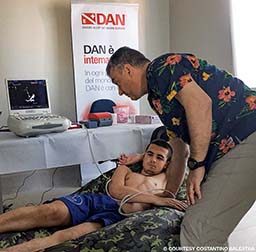Costantino Balestra, Ph.D., has spent his life coming up with groundbreaking hypotheses in research labs and applying them to the real world. His interests have driven him to create unique solutions to challenging issues in biomechanics and neurophysiology and to advance our understanding of medicine and motor science. For the past three decades he has brought his skills and knowledge to bear in dive medicine and research. As director of special projects for the Diving Safety Laboratory and vice president of research and education for DAN Europe, Balestra has forever changed the way that dive research is conducted and the way we understand the physiology and biomechanics of diving.

Research into diving physiology and conditions such as diabetes, patent foramen ovale (PFO) and neurological damage from bubbling have long been Balestra’s passions, and he has spent his career pushing for divers to understand as much as they can about dive medicine and physiology by providing education and training to any who are willing to learn. He is on the forefront of decompression physiology and bubble research and has received multiple Per Zetterström awards from the European Underwater and Baromedical Society (EUBS), a KINE 2000 prize and a Van Goethem-Brichant Foundation award and was recognized as the 2002 DAN-EUBS Scholar.
In addition to being full professor at Haute Ecole Bruxelles-Brabant and director of the Environmental and Occupational (Integrative) Physiology Laboratory, Balestra works for DAN Europe and is also a resident scholar at,Vrije Universiteit Brussel and Université Libre de Bruxelles and the vice president of the Belgian Society for Diving and Hyperbaric Medicine.
You’ve been involved in dive science and medicine for much of your career. What first drew you to diving?
I started to dive in 1986 after completing a master’s degree in health and motor sciences; then I started research in dive medicine and neurophysiology, which ultimately led to a thesis defense on the physiology of human fatigue in 1995. An annexed thesis focused on Doppler analysis of venous gas emboli in disabled scuba divers.
I began diving because my twin brother, Claudio, was paralyzed in a gymnastics accident while practicing on the high rings at the age of 19. I took care of him during our time at university and wanted to find something new to help him enjoy life — gravity had quickly become his worst enemy. Scuba diving became the perfect activity for both of us, so I started the Wet Wheels dive club for the disabled and had my first contacts with DAN Europe. This connection helped spark my investigations into diving and environmental physiology and inspired a trip to the Hyperbaric Center of the Military Hospital, where I met Dr. Peter Germonpré. We quickly found similar interests, and I proposed a study on the effect of PFO on divers. In 1998 we published two papers on the subject and began a long history of friendship and collaboration in research.
Do you still dive? What types of diving do you enjoy?

I do still dive, although not as often as I would like, and I’m still an active instructor trainer for several agencies. I enjoy diving rebreathers and exploring the usage of military diving technology. For example, I use military oxygen rebreathers to dive in the pool with paralyzed divers as part of a rehabilitation program we have developed together with the Center for Traumatology and Readaptation of the Brugmann University Hospital in Brussels. The Wet Wheels club is linked to that hospital and is now run by some of my former students. I remember also that Alessandro Marroni began a similar program of in-water rehabilitation years ago and found it useful and enjoyable for the patients. It’s an interesting and challenging way to combine my interests and provide a good experience for injured divers or those who are interested in diving.
Outside of recreation and research related to diving, what do you do in your free time?
I play saxophone when I can and practice gymnastics and trampoline routines almost every week, although I do not know for how long I can continue that — it really is a sport for young people. I also enjoy dancing and teaching courses on wilderness first aid. Considering the nearest medical post is almost a 12-hour trip, the courses can be quite entertaining and challenging for myself and the students alike.
Has your research taught you anything unexpected over the years, whether that be a specific finding or a trend across multiple projects?
The joy of my research is that almost everything was unexpected. For instance, when I studied muscular fatigue I expected every neurophysiological signal to decrease as the patient became fatigued, but we found that the transcortical long loop did not. This also led us (over the course of several years) to add significantly to our understanding of respiratory triggers in extreme breath-hold diving. In fact a link between respiratory centers in the brain stem and muscular long loop reflexes is actually known.
When studying the erythropoietin (EPO) response (the mechanism that triggers red blood cells to be formed in bone marrow) to pure oxygen prebreathing at normal atmospheric pressure (normobaric oxygen), we expected a decrease because hypoxia triggers EPO. We found quite the opposite to be the case, with a rebound increase of almost 160 percent in some subjects. Working from that, we hypothesized that breathing pure oxygen at above atmospheric pressure (hyperbaric oxygen) could catalyze an even greater response since the exposure to the partial pressure of oxygen would be greater, but we found the opposite was true. We call this the “normobaric oxygen paradox,” and normobaric oxygen has been used to help patients recover from surgery, fight anemia and fare better under chemotherapy.
You have worked to develop new methods to easily and accurately screen divers for PFO. Where do we stand on PFO detection methods?
For years we wanted to do a prospective study to evaluate the relative risk of decompression sickness (DCS) in divers with a PFO. To achieve this goal, we screened a significant number of divers for PFO and followed over time both those with and without presence of PFO to see if the presence of PFO increases the risk of DCS. A study of this type could be made possible only with an easy, cost-effective and minimally invasive PFO detection system, so we started training physicians on bubble-contrasted carotid Doppler screening, which can detect a right-to-left shunt of any origin. The results are ready and will soon be published, but I can already tell you that they are very encouraging for the dive community.
Your research has shown great variability in postdive echocardiography results in divers performing standardized dives. What is the most likely cause of this variability, and is it possible that some divers are more prone to bubbling than others?
We did indeed perform many postdive echocardiographs with very tightly controlled and standardized dives. There appeared to be multiple types of bubblers: one group that consistently bubbled almost the same way for each dive, another that bubbled inconsistently and yet another that bubbled very little. In addition to this variability, one can bubble early and quickly decrease the number of bubbles or start bubbling later with the same theoretical tissue saturation, hydration, temperature and water conditions.
Of course, the genetic answer to the propensity to bubbling is something that we would love to find, but the results are not yet definite enough to identify the triggering genes. We have tried to genetically analyze some heavy and consistent bubblers but could not find anything significant. Some similar experiments on rats performed in France have shown promising results in both genetic propensity to bubble and the ability to breed rats with significantly decreased bubble counts and DCS symptoms. Interestingly, this research has indicated that if there is an inheritability of genes that may protect against DCS, it may be in the X chromosome, but more research is needed on this front.
Some of your work has focused on the safety of diabetic divers, particularly in self-assessing fitness to dive. What is the status of diabetic divers in the sport, and how can diabetic divers improve their safety in the water?
Several years ago we demonstrated that a diabetic diver can supplement glucose underwater fairly safely. This should not be common practice, however; a vigorous self-assessment is mandatory for diabetic divers. Interestingly, while analyzing the glycemia of nondiabetic divers we found two episodes of glycemia under 0.7 grams per liter in two nondiabetic divers. It seems that everyone, not just diabetic divers, should consider the risks of hypoglycemia underwater. Technology can offer some serious benefits in this area, and soon dive computers may be able to measure hypoglycemia underwater. An upcoming publication form DAN Europe illustrates some encouraging results with a prototype of such a device.
Your research has indicated that enriched air nitrox (EANx) could protect against neurocognitive impairments at depth. What do we know about narcosis, and how could EANx help divers? Are there current recommendations for nitrox and narcosis?
Our research focused on testing divers at several depths and oxygen content levels. It quickly became clear that neuropsychometric tests were better in the divers with higher levels of oxygen in their breathing gas. We found that their brain metabolic rates were increased as well.

You’ve pushed hard for research to understand the physiology of diving, despite the fact that divers are a small subset of the population. What can the larger public gain from this research?
Since the creation of the sport, researchers have worked to understand divers for many reasons. In any extreme environment — and diving may be considered an extreme exposure even if the workload is not extreme, because you need special equipment to survive — the way humans react individually and physiologically is of great interest for clinical patients. What we learn from the body’s response to diving can be directly transposed to clinical patients and the elderly because many of the body’s reactions to disease are similar. For example, we have found nonpermanent changes in endothelial function in the vascular system of divers that very closely mimic what we find in several diseases and aging. Learning how to prevent or cope with it is important, regardless of the cause. Astronauts are also interested in diving physiology — divers have a lot in common with astronauts and are much easier to analyze in large numbers.
Predive conditioning — the use of physiological or pharmacological stimuli to increase resistance to particular injuries or illnesses such as DCS — is a rapidly growing field, and it covers those going into space, saturation divers and now sport divers. You’ve worked on several preconditioning techniques, including the ingestion of dark chocolate before a dive, as ways to improve dive safety. What has the research shown, what are the current recommendations, and what is the future of preconditioning?
What we have found regarding preconditioning has been entirely contrary to what we expected. Bubble dynamics may not be directly related to endothelial function and nitric oxide levels; chocolate, for example, is very good at maintaining postdive endothelial function but doesn’t seem to affect bubble production.
We understand that supersaturation and desaturation can’t explain everything about bubble production after diving, but the bubble “seeds,” or micronuclei, are very important. We theorize that by reducing their numbers we will be able to reduce postdive bubble count, and preconditioning is likely to be an important part of this.
New decompression procedures that evolve will use such parameters. Our work aims to reduce not just the incidence of DCS but also the precursors to DCS that we call decompression stress — a mix of inflammatory, oxidative, desaturation and supersaturation bubble effects. The research in this area is very promising but is not quite ready for widespread use. I expect that we will see results soon, but I cannot advise further on the subject quite yet.
| © Alert Diver — Q3 2018 |